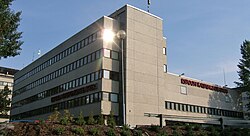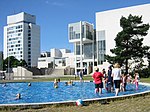Länsiväylä

Länsiväylä (the Western Highway, Swedish: Västerleden) is a motorway in the Greater Helsinki area of Finland, mainly at the Helsinki conurbation. It is part of the Finnish national road 51. The road begins in Ruoholahti in western Helsinki and continues west through the island of Lauttasaari and then across the city border to Espoo. The Länsiväylä road continues all the way throughout the southern part of Espoo. It continues as a motorway until finally crossing the border west to Kirkkonummi. At the start of Länsiväylä is the Lapinlahti bridge built in 1965, which was the longest bridge in Finland for a long time. In September 2013 the average daily traffic over the bridge was 56,710 cars, according to calculations by the city of Helsinki.Länsiväylä is perhaps the most important connection between the cities of Helsinki and Espoo. Almost all bus and private car traffic between central Helsinki and southern Espoo (such as the Tapiola and Otaniemi districts) passes along Länsiväylä. Along with the beltways Ring I and Ring III, it is one of the roads with heaviest traffic in the country. It was constructed as a motorway and compared to the beltways, has been much better suited to heavy traffic. An extensive bus rapid transit network utilizes Länsiväylä, using special bus lanes. However, the Länsimetro extension of the Helsinki Metro, which was completed in autumn 2017, replaced most bus routes on Länsiväylä. A similar road, the Itäväylä (Eastern Highway, Swedish: Österleden) begins at Sörnäinen and continues eastwards towards Sipoo.
Excerpt from the Wikipedia article Länsiväylä (License: CC BY-SA 3.0, Authors, Images).Länsiväylä
Westendinkatu, Espoo Westend (Suur-Tapiola)
Geographical coordinates (GPS) Address Nearby Places Show on map
Geographical coordinates (GPS)
| Latitude | Longitude |
|---|---|
| N 60.168333333333 ° | E 24.794444444444 ° |
Address
Westendinkatu
Westendinkatu
02120 Espoo, Westend (Suur-Tapiola)
Finland
Open on Google Maps









